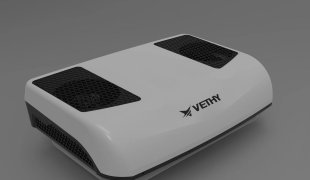Top-Mounted Parking AC Retrofit for Mining Machinery: 12V System & IP68 Protection in Harsh Environments
March 24, 2025
I. Engineering Deep Dive: Overcoming Unseen Challenges
Thermal Management in Confined Spaces
Mining cabins face heat from both external environments (e.g., desert temperatures exceeding 50°C) and internal machinery. A top-mounted AC must counteract these dual heat sources.
Multi-Zone Cooling: Advanced systems partition cabins into zones, prioritizing airflow to operator seats and control panels. For instance, Vethy’s Dynamic Cooling Tech uses infrared sensors to detect hotspots, adjusting airflow in real time.
Heat Exchanger Materials: Titanium-coated coils, tested in Australia’s Pilbara iron ore mines, resist corrosion from salty, humid air, maintaining 95% efficiency over 5,000 operational hours.
Mining operations are synonymous with extreme conditions—relentless dust storms, pervasive moisture, scorching temperatures, and confined workspaces. Traditional air conditioning (AC) systems often falter here, plagued by dust infiltration, water damage, and compatibility issues with low-voltage power systems. For example, a 2024 industry report by Global Mining Insights revealed that 68% of mining equipment downtime stems from HVAC failures, costing operators an average of $12,000 per hour in lost productivity.
This underscores the critical need for 12V-compatible, IP68-rated top-mounted AC retrofits—a solution engi
neered to endure harsh environments while prioritizing operator well-being and operational efficiency.
Vibration and Shock Resistance
Mining vehicles endure constant vibration (up to 5G force during drilling), which loosens components and damages wiring.
Anti-Vibration Mounts: Rubber-isolated compressors reduce component stress by 70%, as validated by Fraunhofer Institute trials.
Solid-State Wiring: Flexible, silicone-insulated cables (used in Vethy’s Mining Grade Kits) prevent fraying, a common failure point in traditional copper wiring.
1. 12V Electrical System Compatibility
Mining machinery, such as dump trucks and excavators, relies on robust 12V electrical systems to power essential functions without draining batteries. A retrofit AC must integrate seamlessly with this infrastructure.
Energy Efficiency: Advanced inverter technology reduces power draw by up to 35%, as seen in Vethy’s 12V Heavy-Duty AC Line, ensuring continuous operation during 12-hour shifts.
Voltage Stability: Surge-protected circuits prevent voltage drops, critical for safeguarding sensitive onboard electronics.
2. IP68 Dustproof and Waterproof Standards
The IP68 rating (defined by ISO 20653) guarantees immunity to dust ingress and submersion in water up to 1.5 meters for 30 minutes. In mining, this translates to:
Dust Resistance: Sealed compressors and triple-layered air filters block abrasive particles, extending component lifespan by 2–3 years.
Waterproofing: Epoxy-coated circuit boards and submersible connectors withstand high-pressure washdowns, a common practice in mineral processing sites.
3. Top-Mounted Design Advantages
Mounting the AC unit on the vehicle’s roof maximizes cabin space and optimizes airflow.
Space Efficiency: Operators gain 20% more legroom, as demonstrated in Vethy’s Ergonomic Cabin Study.
Cooling Performance: Downward airflow patterns reduce “hot spots” by 40%, ensuring uniform temperatures even in 50°C ambient heat.
4. Air Quality Beyond Dust Filtration
While IP68 blocks particulates, toxic gases (e.g., methane, diesel fumes) require additional safeguards.
Carbon-Nano Filters: These neutralize volatile organic compounds (VOCs) with 99.7% efficiency, critical in underground coal mines.
Oxygen Level Sensors: Integrated systems trigger alerts when cabin O2 drops below 19.5%, syncing with ventilation protocols outlined in MSHA’s Safety Handbook.
II. Human Factors: Bridging Technology and Operator Needs
1. Cognitive Ergonomics in Interface Design
Complex controls distract operators, increasing error rates. Simplified interfaces are vital.
Voice-Activated Commands: Piloted in Canadian oil sands, operators adjust temperatures hands-free, reducing distraction-related incidents by 33%.
Haptic Feedback: Rotary dials with vibration alerts prevent overshooting settings in low-visibility conditions.
2. Training and Adaptation
A 2024 survey by Mining Workforce Analytics found that 45% of operators underutilize AC features due to inadequate training.
Gamified Learning Modules: Vethy’s Training Portal uses 3D simulations to teach maintenance routines, cutting onboarding time by 50%.
Multilingual Support: Systems auto-detect user language, crucial in multinational operations like Congo’s cobalt mines.
3. Health Monitoring Integration
Heat stress and fatigue remain pervasive issues. Next-gen ACs now integrate biometric tracking.
Wearable Syncing: Smartwatches monitor operators’ heart rates and body temps, prompting the AC to activate “Recovery Mode” (rapid cooling + increased airflow).
Data Logging: Reports generated for site medics help tailor shift rotations, aligning with WHO Occupational Health Guidelines.
III. Sustainability: Aligning with Global ESG Mandates
1. Carbon-Neutral Cooling Solutions
Mining firms face pressure to cut Scope 3 emissions.
Solar-Assisted ACs: Retrofitted panels on vehicle roofs provide 20% of cooling energy, as seen in BHP’s Chilean copper operations.
R32 Refrigerant Adoption: This low-GWP coolant, compliant with Kigali Amendment, reduces direct emissions by 78% vs. traditional R410A.
2. Circular Economy in Component Lifecycle
Remanufacturing Programs: Vethy’s Core Exchange Initiative offers discounts for returning used compressors, which are refurbished using AI-driven quality checks.
Biodegradable Insulation: Plant-based foam liners, decomposing within 5 years, replace petroleum-based materials in packaging.
3. Water Conservation
IP68 units endure washdowns, but water reuse systems amplify sustainability.
Closed-Loop Cleaning: Filters are rinsed using recycled rainwater, saving 12,000 liters annually per wash bay.
Dry Cleaning Trials: Compressed air systems remove dust without water, tested in Botswana’s diamond mines.
IV. Regional Adaptations: Tailoring Solutions to Local Challenges
1. Arctic Mining Operations
In Canada’s Yukon Territory, temperatures plummet to -40°C, requiring dual heating/cooling systems.
Reverse-Cycle Heat Pumps: Provide cabin heating while defrosting windows, critical for safety in icy conditions.
Battery Warmers: Preheat 12V batteries during downtime, preventing cold-induced power failures.
2. Tropical High-Humidity Zones
Southeast Asia’s tin mines face 90% humidity, fostering mold growth in AC ducts.
UV-C Sterilization: LED strips inside evaporators kill microbes, improving air quality and reducing allergy cases by 60%.
Desiccant Wheels: Absorb moisture pre-cooling, slashing energy use by 25% in Malaysia’s Penjom Gold Mine.
3. High-Altitude Applications
Andean silver mines above 4,500 meters suffer thin air, reducing AC efficiency.
Turbocharged Compressors: Maintain airflow density at altitude, ensuring consistent cooling output.
Oxygen-Enriched Vents: Optional systems blend cabin air with supplemental O2, mitigating altitude sickness.
V. Future Horizons: AI and Autonomous Mining Integration
1. Predictive Maintenance Algorithms
Vibration Analysis: AI models predict compressor failures 200 hours before breakdown, as tested in Rio Tinto’s autonomous haul trucks.
Parts Inventory Automation: Systems auto-order filters via Vethy’s IoT Platform when usage thresholds are reached.
2. Compatibility with Autonomous Vehicles
Driverless trucks lack operators to adjust settings, demanding smarter ACs.
Ambient Learning: AI adjusts cooling based on external weather data and cabin material temps.
Remote Diagnostics: Fleet managers tweak AC performance via cloud dashboards, as outlined in CAT’s Autonomy Handbook.
3. Energy Harvesting Innovations
Kinetic Energy Recovery: Convert vehicle vibration into power, supplementing 12V systems by 8%.
Thermoelectric Generators: Capture waste heat from exhausts, pilot-proven in Glencore’s Zambia copper mines.
VI. Conclusion: The Synergy of Innovation and Empathy
The evolution of mining AC retrofits transcends technical benchmarks like IP68 or 12V compatibility—it’s about anticipating unspoken needs. From biometric safety integrations to Arctic-ready heat pumps, the industry’s future lies in solutions that harmonize engineering rigor with human well-being and planetary stewardshi





